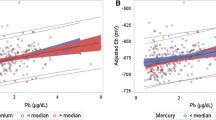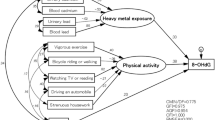Abstract
Immigrants lack appropriate health care access and other resources needed to reduce their exposure to preventable environmental health risks. Little is known about the impact of lead exposure and oxidative stress among immigrants. Thus, this study was to examine the differences between the blood lead levels (BLLs) and oxidative stress levels of immigrants and non-immigrants, and to investigate the determinants of increased BLLs or oxidative stress levels among immigrants. We collected demographic data of 239 immigrant women and 189 non-immigrant women who resettled in the central area of Taiwan. Each study participant provided blood samples for genotyping and for measuring blood metal levels and oxidative stress. Recent immigrants were at risk for elevated BLLs. Decreased BLLs, malondialdehyde (MDA), and increased blood selenium levels were significantly associated with duration of residence in Taiwan. Elevated BLLs and MDA in recent immigrants may serve as a warning sign for the health care system. The nation’s health will benefit from improved regulation of living environments, thereby improving the health of immigrants.
Similar content being viewed by others
References
International Organization for Migration. Facts and figures. http://www.iom.int/jahia/Jahia/about-migration/facts-and-figures/lang/en. Accessed 2012.
Ministry of the Interior ROC. The statistics of marriage registration and number of birth by Bride’s Nationality in Taiwan. 2011.
Tong S, McMichael AJ, Baghurst PA. Interactions between environmental lead exposure and sociodemographic factors on cognitive development. Arch Environ Health. 2000;55:330–5.
Fewtrell LJ, Pruss-Ustun A, Landrigan P, Ayuso-Mateos JL. Estimating the global burden of disease of mild mental retardation and cardiovascular diseases from environmental lead exposure. Environ Res. 2004;94:120–33.
Bellinger DC. Teratogen update: lead and pregnancy. Birth Defects Res A Clin Mol Teratol. 2005;73:409–20.
ATSDR. Toxicological profile for lead: agency for toxic substances and disease registry 2007.
Landrigan PJ. The worldwide problem of lead in petrol. Bull World Health Organ. 2002;80:768.
CDC. Elevated blood lead levels among internationally adopted children–United States, 1998. JAMA. 2000;283:1416–8.
Lead exposure among females of childbearing age–United States, 2004. Morb Mortal Wkly Rep 2007;56:397–400.
Binns HJ, Kim D, Campbell C. Targeted screening for elevated blood lead levels: populations at high risk. Pediatrics. 2001;108:1364–6.
Hayashi Y, Doi K, Yagishita M, Kuwata M. Urban transport sustainability: Asian trends, problems and policy practices. Europ J Transp Infrast Res. 2004;4:27–45.
Kosnett MJ, Wedeen RP, Rothenberg SJ, Hipkins KL, Materna BL, Schwartz BS, Hu H, Woolf A. Recommendations for medical management of adult lead exposure. Environ Health Perspect. 2007;115:463–71.
Zhao Y, Wang L, Shen HB, Wang ZX, Wei QY, Chen F. Association between delta-aminolevulinic acid dehydratase (ALAD) polymorphism and blood lead levels: a meta-regression analysis. J Toxicol Environ Health A. 2007;70:1986–94.
Kelada SN, Shelton E, Kaufmann RB, Khoury MJ. Delta-aminolevulinic acid dehydratase genotype and lead toxicity: a HuGE review. Am J Epidemiol. 2001;154:1–13.
Feder JN, Penny DM, Irrinki A, Lee VK, Lebron JA, Watson N, Tsuchihashi Z, Sigal E, Bjorkman PJ, Schatzman RC. The hemochromatosis gene product complexes with the transferrin receptor and lowers its affinity for ligand binding. Proc Natl Acad Sci USA. 1998;95:1472–7.
Wang FT, Hu H, Schwartz J, Weuve J, Spiro AS, Sparrow D, Nie H, Silverman EK, Weiss ST, Wright RO. Modifying effects of the HFE polymorphisms on the association between lead burden and cognitive decline. Environ Health Perspect. 2007;115:1210–5.
Rezende VB, Barbosa F Jr, Montenegro MF, Sandrim VC, Gerlach RF, Tanus-Santos JE. Haplotypes of vitamin D receptor modulate the circulating levels of lead in exposed subjects. Arch Toxicol. 2008;82:29–36.
Zmuda JM, Cauley JA, Ferrell RE. Molecular epidemiology of vitamin D receptor gene variants. Epidemiol Rev. 2000;22:203–17.
Tsuchihashi Z, Hansen SL, Quintana L, Kronmal GS, Mapa FA, Feder JN, Wolff RK. Transferrin receptor mutation analysis in hereditary hemochromatosis patients. Blood Cells Mol Dis. 1998;24:317–21.
Ahamed M, Siddiqui MK. Low level lead exposure and oxidative stress: current opinions. Clin Chim Acta. 2007;383:57–64.
Armstrong D, Browne R. The analysis of free radicals, lipid peroxides, antioxidant enzymes and compounds related to oxidative stress as applied to the clinical chemistry laboratory. Adv Exp Med Biol. 1994;366:43–58.
Yagi K. Simple assay for the level of total lipid peroxides in serum or plasma. Methods Mol Biol. 1998;108:101–6.
Marklund S. Distribution of CuZn superoxide dismutase and Mn superoxide dismutase in human tissues and extracellular fluids. Acta Physiol Scand Suppl. 1980;492:19–23.
CDC. Laboratory procedure manual-lead, cadmium, and mercury in whole blood, Atlanta, GA 30333: Centers for Disease Control and Prevention 2004.
Urquia ML, Frank JW, Moineddin R, Glazier RH. Immigrants’ duration of residence and adverse birth outcomes: a population-based study. BJOG. 2010;117:591–601.
Goel MS, McCarthy EP, Phillips RS, Wee CC. Obesity among US immigrant subgroups by duration of residence. JAMA. 2004;292:2860–7.
Hernandez-Avila M, Gonzalez-Cossio T, Palazuelos E, Romieu I, Aro A, Fishbein E, Peterson KE, Hu H. Dietary and environmental determinants of blood and bone lead levels in lactating postpartum women living in Mexico City. Environ Health Perspect. 1996;104:1076–82.
Moller P, Loft S. Oxidative damage to DNA and lipids as biomarkers of exposure to air pollution. Environ Health Perspect. 2010;118:1126–36.
Yesilbursa D, Serdar Z, Serdar A, Sarac M, Coskun S, Jale C. Lipid peroxides in obese patients and effects of weight loss with orlistat on lipid peroxides levels. Int J Obes (Lond). 2005;29:142–5.
Fernandez-Sanchez A, Madrigal-Santillan E, Bautista M, Esquivel-Soto J, Morales-González A, Esquivel-Chirino C, Durante-Montiel I, Sánchez-Rivera G, Valadez-Vega C, Morales-González JA. Inflammation, oxidative stress, and obesity. Int J Mol Sci. 2011;12:3117–32.
Combs GF Jr. Selenium in global food systems. Br J Nutr. 2001;85:517–47.
Rayman MP. The importance of selenium to human health. Lancet. 2000;356:233–41.
Karapanou O, Papadimitriou A. Determinants of menarche. Reprod Biol Endocrinol. 2010;8:115.
Patrick L. Lead toxicity part II: the role of free radical damage and the use of antioxidants in the pathology and treatment of lead toxicity. Altern Med Rev. 2006;11:114–27.
Romieu I, Castro-Giner F, Kunzli N, Sunyer J. Air pollution, oxidative stress and dietary supplementation: a review. Eur Respir J. 2008;31:179–97.
Acknowledgments
This work was supported by the National Science Council, Taipei, Taiwan (NSC 97-2314-B-039-016-MY2). The authors thank all the study participants and WC Shih, MJ Hong, SJ Lin, and the staff from the Public Health Center in central Taiwan.
Author information
Authors and Affiliations
Corresponding author
Additional information
W.-T. Wu and C.-C. Wu are co-first authors.
Rights and permissions
About this article
Cite this article
Wu, WT., Wu, CC., Lin, YJ. et al. Changing Blood Lead Levels and Oxidative Stress with Duration of Residence Among Taiwan Immigrants. J Immigrant Minority Health 15, 1048–1056 (2013). https://doi.org/10.1007/s10903-013-9820-x
Published:
Issue Date:
DOI: https://doi.org/10.1007/s10903-013-9820-x




